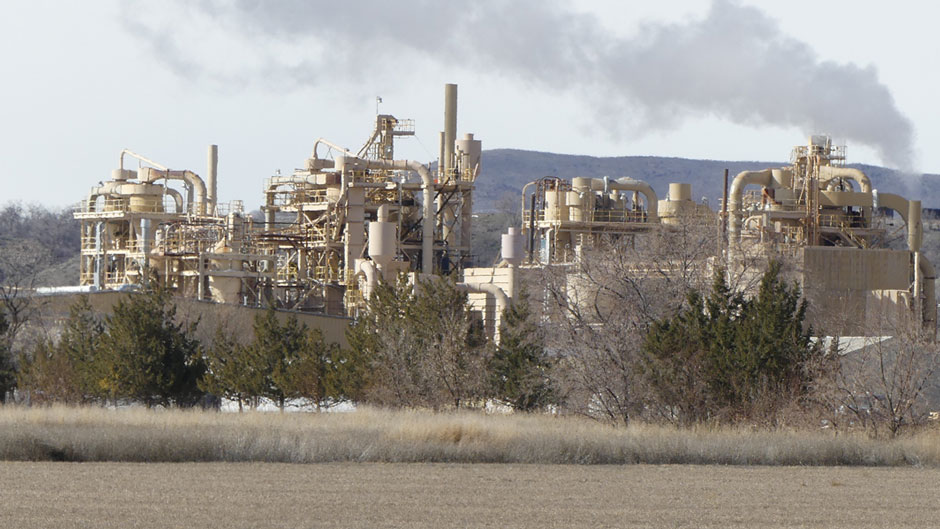
EP Minerals, a local firm that produces diatomaceous rock, could leave the state if a new carbon emissions plan is approved, according to a local legislator. (The Enterprise/Pat Caldwell).
VALE – If legislators give a green light to a plan to slash the state’s carbon emissions, one of Malheur County’s major employers and one nearby in Baker County may shut down.
State Rep. Lynn Findley, R-Vale, told lawmakers last week that EP Minerals, a global producer of diatomaceous rock with a plant east of Vale, will likely depart if lawmakers pass House Bill 2020, the proposal to limit carbon emissions.
“We must do no harm to existing business, understand the economic impacts of this law, and not destroy the ability of Oregon businesses to complete,” Findley warned lawmakers.
EP Minerals, headquartered in Nevada, employs 115 people in Malheur County with an annual payroll of more than $5 million. EP Minerals has an assessed property value of $16 million and paid about $161,000 in taxes last year.
The firm is the ninth largest taxpayer in Malheur County.
In a statement, EP Minerals said, “Our employment substantially contributes to the rural Oregon economy and creates additional jobs through vendors that service our needs at Vale.”
The Vale EP Minerals plant is “emission-intensive,” which means the proposed legislation will impact its operations.
In the statement, EP Minerals said it already “implemented multiple emissions reduction initiatives at Vale.”
EP Minerals operates a facility in Nevada that would not be subject to regulations in House Bill 2020. That plant, said the EP Minerals statement, could “be expanded to accommodate Vale’s operations.”
“For purposes of long term planning, EP seeks assurance that no carbon tax will be implemented in Oregon,” said the company statement.
Findley said rural economics like Malheur County’s are “extremely fragile.”
“Any reduction of employment diversity, such as this, is very significant,” said Findley.
Findley’s speech was just the latest in what is fast becoming a flashpoint issue for residents, civic leaders and elected officials across eastern Oregon.
The proposal has the support of influential Democratic lawmakers – such as House Speaker Tina Kotek, D-Portland and Senate President Peter Courtney, D-Salem. Gov. Kate Brown also supports the plan.
At once simple and complex, the proposal creates a new emission standard for the state.
The emission standard applies to companies that discharge more than 25,000 metric tons of carbon dioxide equivalents each year.
Carbon dioxide equivalents are part of a complicated scientific calculation that essentially measures how much greenhouse gas is entering the atmosphere.
The goal is to slash the state’s greenhouse gas emission to 1990 levels by 2021.
Companies that exceed the 25,000-metric ton limit would be required to buy special certificates – called allowances – at a state-sponsored auction. Firms can then trade those certificates on a specialized carbon market similar to ones already in place in California and Canada.
Critics of the proposal charge it will damage the state’ economy by hiking fuel prices – as much as 16 cents a gallon by some estimates – while supporters assert the blueprint will help the environment and curb climate change.
A public hearing Feb. 25 in Baker City attracted a standing-room-only crowd from across the region. Malheur County officials, merchants and farmers testified during the hearing sponsored by the Legislature’s Joint Carbon Reduction Committee at the Baker County Fairgrounds Event Center. About ten people from Malheur County – including Riley Hill, Ontario mayor, and Adam Brown, Ontario city manager – testified during the session.
The consensus of most was the proposed legislation would damage eastern Oregon’s economy by raising fuel prices, stifle growth and do little to help the environment.
Kevin Corn, a Malheur County farmer, told the committee that the emission plan would give foreign competitors an unfair advantage and “do not make any allowance for alternative methods.”
“We are a local economy that competes on world market. Our trading partners will not have to shoulder these new expenses to production,” said Corn.
Hill testified that the proposed legislation would send Malheur County residents and businesses to Idaho to avoid its costs.
Hill said Ontario businesses such as Love’s Travel Stop & Country Store, Pilot Travel Stop, Kraft Heinz Company and small gas stations could leave.
“The cap and trade bill will have the opposite effect that Oregonians espouse: Diversity, inclusiveness, equity and create a polarizing effect,” said Hill.
Hill said later the emission cap idea “will wipe us out if they pass it.”
Brown told the panel that all that splits Idaho from Oregon is a 1,000-foot bridge over the Snake River.
That bridge, he said, represents more than just concrete.
“It’s all that separates us from a completely different economic world, a tale of two cities. Ontario is on one side and Fruitland, Idaho, is on the other,” said Brown.
While Fruitland thrives, Ontario struggles, said Brown.
Brown said Malheur County industry has “every reason to move across the 1,000-foot bridge to Idaho and this legislation just may be the tipping point.”
Both in his testimony Feb. 25 and late last week, Brown suggested if the proposed legislation is approved, eastern Oregon should be excluded from its mandates.
“I would hope that they would carve out eastern Oregon and at least study the impacts,” said Brown. Jim Maret, Nyssa city manager, also testified Feb. 25, warning what little growth there is in Malheur County would stop if the emission cap is approved.
“It will not make us stronger but poorer. It is not good for the economy of Oregon at all and it will give Idaho an upper hand on us,” said Maret.
EP Minerals and Kraft Heinz Company are not the only regional firms that could be hit hard by the emissions legislation.
Ash Grove Cement operates a plant near Durkee in Baker County and company officials testified the proposed emissions plan would hurt the firm.
That’s because it will create an unfair trade playing field with China, which also produces cement but would not face the same regulation as Ash Grove Cement.
“Our plant cannot remain competitive if additional costs are imposed that are not imposed on our competitors,” said Terry Kerby, the plant manager.
Ash Grove Cement employs 115 people with an annual payroll of $13 million. Ash Grove is also the third largest property taxpayer in Baker County. Last year the firm injected about $700,000 in county coffers.
Curtis D. Lesslie, vice president of environmental affairs for Ash Grove cement, wrote in submitted testimony to the legislative panel the emissions blueprint carries serious unintended consequences.
Lesslie wrote that “those 116 jobs in Durkee will be lost permanently if the carbon policies under discussion are applied to Oregon cement operations.”
Reporter Pat Caldwell: [email protected] or 541-473-3377.
For the latest news, follow the Enterprise on Facebook and Twitter.
TRY A FREE SAMPLE – You can see for yourself the kind of local news reporting produced by the Malheur Enterprise with a news team focused exclusively on news that’s important to you. You can read us for free for 30 days. Signing up is easy and then you have 24/7 access to our reports. Sign up HERE. Or you can support some of the nation’s best journalism by subscribing to our digital news service for $5 a month, easy and automatic. Subscribe HERE.




